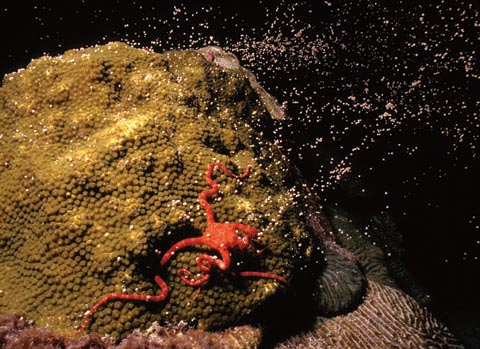Corals can reproduce asexually and sexually. In asexual reproduction, new clonal polyps bud off from parent polyps to expand or begin new colonies. This occurs when the parent polyp reaches a certain size and divides. This process continues throughout the animal’s life.
About three-quarters of all stony corals produce male and/or female gametes (sperm and eggs). Most of these species are broadcast spawners, meaning they release massive numbers of their gametes into the water. They do this to distribute their offspring over as large an area as possible. The eggs and sperm join to form free-floating, or planktonic, larvae called planulae. Large numbers of planulae are produced to compensate for the many hazards, such as predators, that they encounter as they are carried by water currents. The time between the formation of the planulae and the time it settles on the bottom, is a period of exceptionally high mortality among corals.
Along many reefs, spawning occurs as a mass synchronized event, when all the coral species in an area release their eggs and sperm at about the same time. The timing of a broadcast spawning event is very important because males and female corals cannot move into reproductive contact with each other. Colonies may be separated by wide distances, so this release must be both precisely and broadly timed, and usually occurs in response to multiple environmental cues.
The long-term timing of spawning may be related to temperature, day length, and/or rate of temperature change (either increasing or decreasing). The short-term (getting ready to spawn) timing is usually based on lunar cues, or cues from the moon. The final release, or spawn, is usually based on the time of sunset.
Planulae swim upward toward the light, enter surface waters and are transported by the current. After floating at the surface, the planulae swim back down to the bottom, where, if conditions are favorable, they will settle. Once the planulae settle, they metamorphose (transform) into polyps and form colonies that increase in size. In most species, the larvae settle within two days, although some will swim for up to three weeks, and in one known instance, two months.
In contrast, brooding coral species have internal fertilization and development of their gametes. The planulae are not released until they are fully developed and therefore they tend to spend much less time in the water, are ready to settle much sooner, and usually settle much closer to their parent colonies than broadcast spawning species.
 An official website of the United States government.
An official website of the United States government.




Social